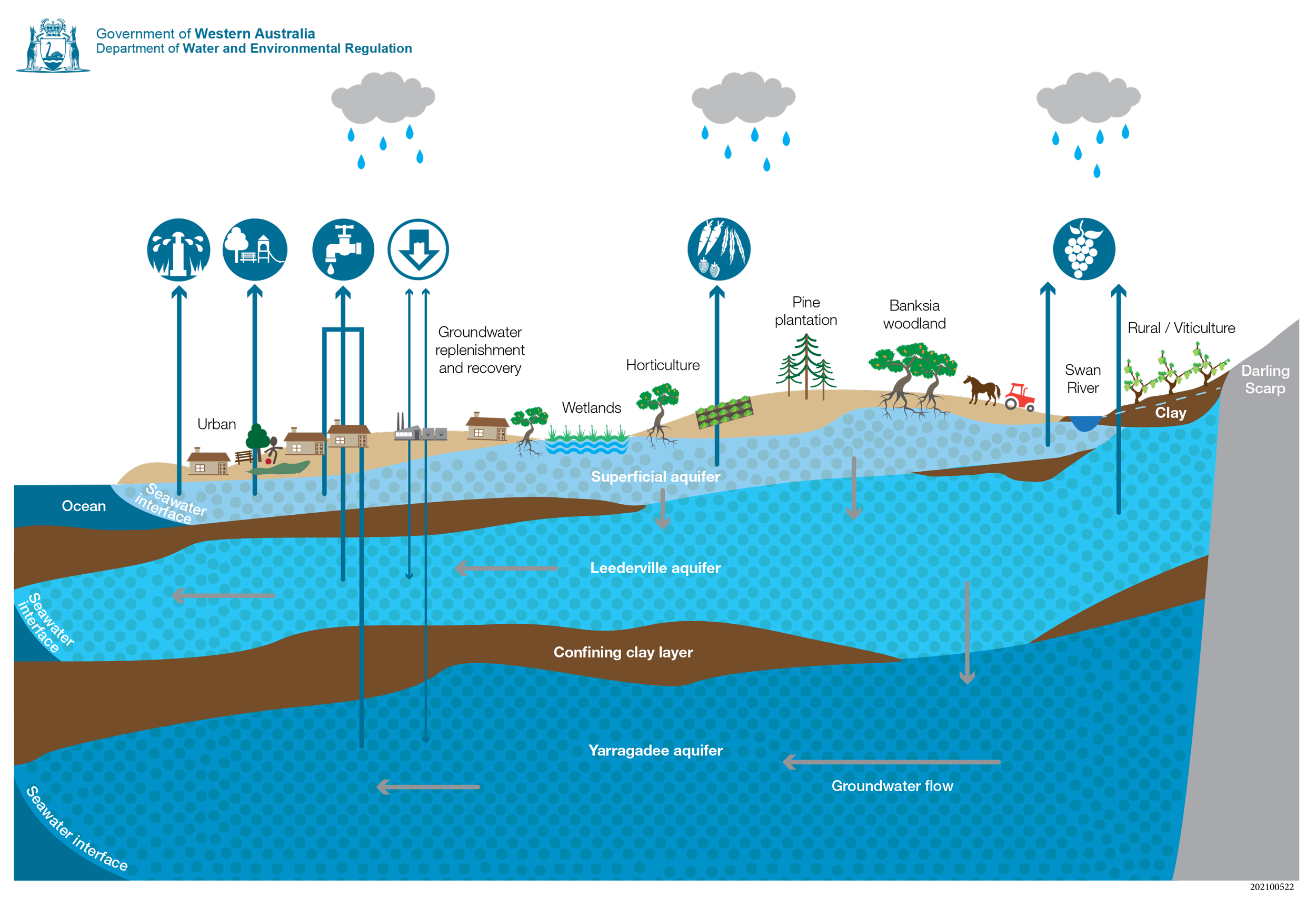The Gnangara groundwater system is a basin of water-holding sands and gravels interspersed with clays, with limestone along the coast in some locations. It underlies Perth between the Hills and the coast and the area from the Swan River (Derbarl Yerrigan) to Gingin Brook. It stretches over 2200 km under the coastal plain.
In the Gnangara system, deeper water is up to 35,000 years old and the geological structure is much older (up to 175 million years old). The system is made of many layers of sediment. Pores between the sand layers hold accessible water, which mostly comes from winter rainfall making its way down through the soil to recharge the aquifers.
The system contains three main aquifers:
- The shallow, unconfined Superficial aquifer (the Gnangara Mound).
- The deep, mostly confined Leederville aquifer.
- The deepest, mostly confined Yarragadee aquifer.
The Gnangara Mound is the common name for the Superficial aquifer in a large mound of sandy soil located north of Perth. The watertable in the aquifer forms a groundwater mound – rainwater recharges groundwater at a higher rate at the top of the mound and then water flows out horizontally through the aquifer towards the rivers and the ocean.
The Gnangara system provides almost half of all the water used in the Perth metropolitan area each year. It supplies water for agriculture, parks, ovals and gardens on the Gnangara system, and water for Perth’s scheme supply – distributed by the Water Corporation. Gnangara groundwater also supports environmental features such as lakes, wetlands and bushland.
The deeper Leederville and Yarragadee aquifers are mostly used for scheme water supply.
History of Gnangara groundwater management
The Gnangara groundwater system has a long history of use and management. The key actions we’ve taken to sustainably manage groundwater use to date have been to set and manage against Ministerial conditions and commitments, and implement the 2009 Gnangara groundwater areas allocation plan. The department has now released the 2022 Gnangara groundwater allocation plan.
Ministerial conditions and commitments were established in 1988 to manage how groundwater was abstracted for public water supply and manage the expected growth in other licensed use at the time.
The 2009 Gnangara groundwater areas allocation plan provided the first steps to returning the over-allocated system to balance. It was a strong step in adjusting our groundwater management in the context of drier climate and resulted in:
- significantly reduced abstraction for public water supply
- increased compliance and enforcement activities
- increased protection of groundwater-dependent ecosystems, by moving abstraction to lower-risk areas.
We evaluated our management against the plan’s objectives and released two evaluation statements:
- Gnangara groundwater areas allocation plan: Evaluation statement 2009–2011
- Gnangara groundwater areas allocation plan: Evaluation statement 2011–2014
The 2022 Gnangara groundwater allocation plan was the next step in adjusting our management and returning the Gnangara system to balance.
The Be Groundwater Wise initiative and other actions under the Waterwise Perth Action Plan and Kep Katitjin – Gabi Kaadadjan – Waterwise Perth action plan 2 are also supporting the rebalancing of the Gnangara groundwater system.
Publications
The Gnangara groundwater allocation plan was published in June 2022.
The Gnangara groundwater allocation plan: Methods sets out the information and considerations used to develop the 2022 new plan.
The Gnangara groundwater allocation plan: Statement of response addresses submissions received from licensees, key stakeholders, and the general public during the public comment period for the draft plan, which was open from 19 November 2021 until 28 February 2022.
Between 19 November 2021 and 28 February 2022, the State Government also sought feedback on a proposal to align the domestic garden bore sprinkler roster with the two-day-a-week scheme water roster. The department would like to thank all those who made submissions and has prepared a consultation report that summarises the submissions and the department’s responses to them. The sprinkler roster change starts on 1 September 2022.
Technical studies that supported the development of the 2022 plan include:
- Studying Perth’s deep aquifers to improve their management: Findings and recommendations from the Perth Region Confined Aquifer Capacity study
- Construction and calibration of the Perth Regional Aquifer Model PRAMS 3.5.2
- Connectivity between the north Yeal wetlands and Perth’s regional groundwater
- Lake Nowergup: Factors in declining lake and groundwater levels
- Loch McNess hydrogeology and causes of water-level decline (1975 - 2011)
You can also view the Environmental compliance reports.



